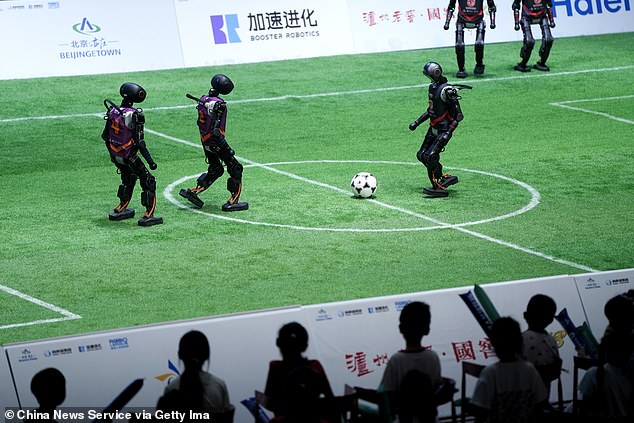
China’s First 3-on-3 Robot Football Match Ends with Two Bots Stretchered Off—Human Jobs Safe for Now
China’s First Robot Football Tournament: Clumsy Bots, Big Ambitions
[Image 1: Robots clumsily maneuvering on a football field. Caption: China’s three-on-three robot football tournament showcased slow, collision-prone players.]
Beijing recently hosted China’s inaugural three-on-three robot football tournament, part of the ROBO League trial ahead of the 2025 World Humanoid Games. While the event marked a milestone in robotics, the robots’ performance was far from World Cup material. The AI-controlled players shuffled slowly, collided frequently, and occasionally toppled over. Two even had to be “stretchered off” after falls—a comical sight compared to human athletes.
Growing Pains
Cheng Hao, founder of Booster Robotics (the event’s bot supplier), admitted the robots currently have the skills of “five-to six-year-old children.” However, he predicts their abilities will grow exponentially, eventually surpassing youth teams and even challenging adult players. Future matches could even pit humans against robots—though safety upgrades are needed first, given the bots’ inability to avoid collisions reliably.
[Image 2: A referee intervening as robots pile up. Caption: Referees often stepped in to untangle crashing robots during matches.]
Technical Hurdles
Four university engineering teams programmed AI strategies for passing, shooting, and recovery. Tsinghua University’s THU Robotics claimed victory with a 5-3 win over China Agricultural University’s Mountain Sea team. Despite the milestone, the bots struggled with “dynamic obstacle avoidance,” bumping into each other even at a sluggish speed of 1 meter per second. Rules were adjusted to allow “non-malicious collisions,” and human assistants occasionally righted fallen bots.
Why Football?
Sports like football test robots’ ability to handle unpredictable scenarios, teamwork, and coordination—key challenges for AI. Cheng Hao emphasized that the tournament helps students apply algorithms to real-world robotics while showcasing advancements in mobility, stability, and safety. Similar efforts, like Google DeepMind’s 2023 miniature football bots, highlight sports as a global AI testing ground.
[Image 3: Robots attempting to kick a ball. Caption: Robots occasionally made contact with the ball—but scoring was rare.]
China’s Robotics Push
China is aggressively developing humanoid robots, using sports to demonstrate progress. Recent events include a robot kickboxing match and the Yizhuang half-marathon, where 21 bots raced humans. The fastest, Tiangong Ultra, finished in 2 hours and 40 minutes—though some models failed to complete the course.
[Image 4: Humanoid robots participating in a marathon. Caption: China’s Tiangong Ultra robot (center) won a recent half-marathon alongside human runners.]
Looking Ahead
While current robot athletes are clumsy, their rapid evolution signals a future where advanced AI could revolutionize both sports and industries. For now, though, the tournament’s slapstick moments prove machines have a long way to go before claiming trophies like the Ballon d’Or.
Word count: ~600
Images: Include 4 images from original article with captions as noted.


